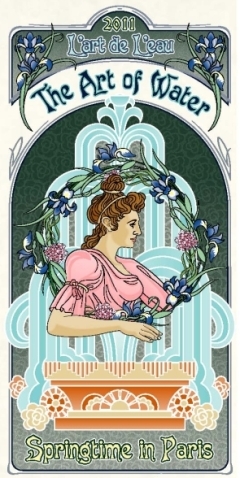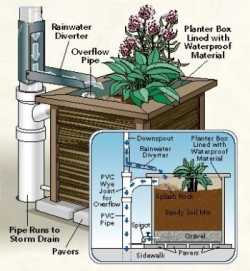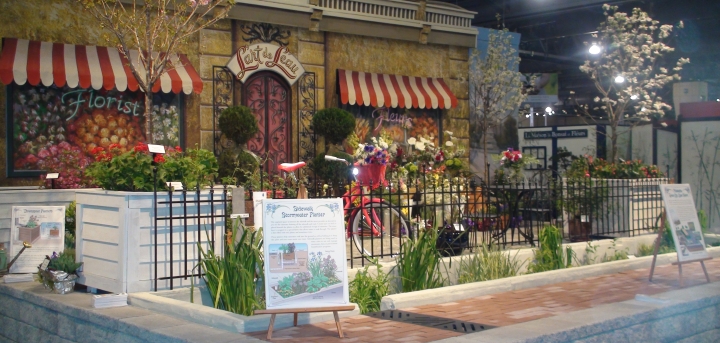2011 Philadelphia International Flower Show

The Philadelphia Water Department is proud to be a part of the 2011 Philadelphia International Flower Show. The theme of our exhibit, co-sponsored by the Partnership for the Delaware Estuary, is "Springtime in Paris." The goal of our exhibit is to correlate the health and cleanliness of local waterways with the beauty of flowers and plants in an urban environment—whether it's Paris in the 1920s or modern-day Philadelphia. On display are three examples of urban stormwater management: a sidewalk stormwater planter, porous pavers and a downspout planter.
PWD recently launched the Green City, Clean Waters plan to unite the City of Philadelphia with its water environment, creating a green legacy for future generations while incorporating a balance between ecology, economics and equity.
As rain or melting snow drains off our yards and roadways, it picks up pollutants (such as trash, leaky engine fluids, animal waste, excess lawn chemicals, etc.). By handling rainwater more naturally we can assure clean and reliable water for fishing, swimming and drinking.
Sidewalk and downspout planters and porous pavers are just a few ways that property owners can help prevent stormwater pollution. These tools slow, absorb and filter the rainwater. Find out more about what you can do to prevent stormwater runoff and preserve our local waterways.
We hope you can stop by the flower show to see the exhibit. This page contains links for the flower show brochure and species list.
Flower Show Information
"The 2011 Philadelphia International Flower Show will transport visitors to the beautiful City of Light – the capital of art, fashion, food, and love. A blooming “Springtime in Paris” will greet guests with a bucolic park scene along the Seine. Flowering trees, lilacs, roses and borders of lavender will lead visitors through gardens inspired by the Tuileries. In the distance, a daring Moulin Rouge atmosphere will pulse with cabaret performances, spectacular flower sculptures and carousel topiaries."
2011 Philadelphia International Flower Show, an event of the Pennsylvania Horticultural SocietyDownspout Planters

These specially designed planters are filled with gravel, soil and then plants. A connection to the roof downspout lets rain flow into the planter and water the plants. There is another pipe that connects back to the existing downspout to drain excess water.
These planters temporarily store water and filter pollutants as the water soaks down through soil and stone in the planters. Downspout planters are typically lined on the inside with some type of waterproofing. They can be constructed in many sizes and shapes, and with various materials, including concrete, brick, plastic, lumber or wood.
These specially designed planters not only help keep our waterways clean, but the plants need far less watering than a typical planter during hot summer months.
Sidewalk Stormwater Planter

Similar to a downspout planter, this vegetated space in between the sidewalk and the street provides an absorption area for the rainwater draining off the sidewalk and road. It is traditionally rectangular, with four concrete sides. A stone layer (or bed) is placed beneath the planter to allow for additional storage of rainwater. The stone layer is wrapped in a special fabric that allows water to soak through. The planter is then filled with soil, plants, and sometimes trees. Oftentimes, the top of the soil in the planter is lower than the sidewalk, allowing for rain to flow into the planter through an inlet at street level. If it rains too much, there is an overflow pipe connected to the existing sewer.
Special plants must be used in these planters. The plants must be species that are able to tolerate wet soils for extended periods of time and dry conditions during droughts. Due to their proximity to the harsh conditions of street life, plants should be hardy and salt-tolerant (winter deicers). Native plants, or plants that would naturally occur in this region, are also suggested. They require fewer pesticides and fertilizers because they have evolved to grow under local conditions.
These planters help rainwater soak into the ground as well as hold the water to keep the plant and tree roots moist over time. Since the rain soaks into the ground within a few days, mosquitoes do not have enough time to reproduce. Sidewalk planters are being used in many cities to not only manage stormwater, but also for street beautification purposes.
Porous Pavers

Where a hard surface is necessary, porous pavers can be used. These interlocking pavers are spaced apart with gravel or grass (not concrete). These spaces allow rain and melting snow to soak into the ground.
This porous surface has a layer of stone underneath. The spaces in between the stone provide temporary storage for the water as it slowly soaks into the ground. Allowing the water to drain into the ground rather than run off into a nearby storm drain can reduce flooding and pollution that would eventually end up in local waterways.
Black ice or the refreezing of melted snow rarely occurs on porous parking lots because water drains through the porous paving, leaving nothing to refreeze at dusk.
There are many different types of porous surfaces, including pervious asphalt, pervious concrete, and these interlocking pavers.
Documents
Brochure Download the 2011 PWD flower show brochure (1.7 MB PDF).
Species List Download the 2011 PWD flower show species list (PDF).
 PWD Exhibit at the 2011 Philadelphia International Flower Show
PWD Exhibit at the 2011 Philadelphia International Flower Show
Project Contributors
Landscaping design and installation by Joe Vetrone
Backdrop designed and painted by Vanessa Fenton
Brochure and signage designed by Frank McShane
Project management by Arthur Holst, Philadelphia Water Department